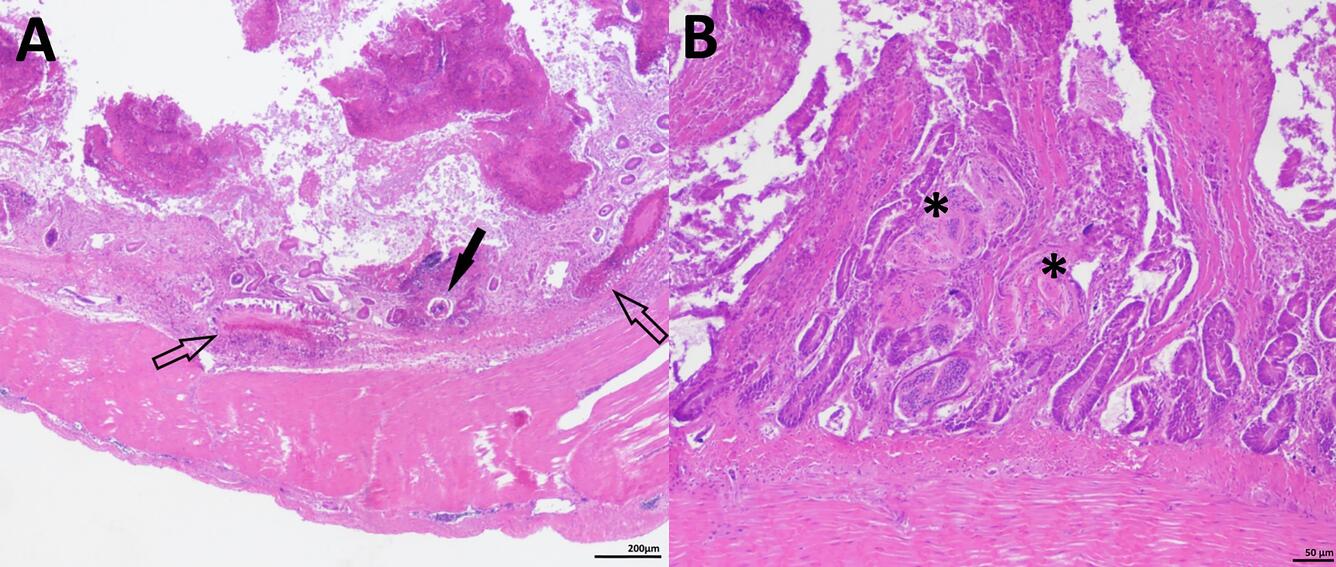Pathology Case of the Month - Mallard Ducks
Case History: In late December 2019, 25 dead mallards (Anas platyrhynchos) were observed in a retention pond belonging to an adjacent factory in Minnesota.
A similar mortality event was reported at this location in January 2016. Because the pond receives warm-water effluent, it does not freeze during cold weather. Two carcasses from the 2019 mortality event were submitted to the USGS National Wildlife Health Center for post-mortem examination.
Gross Findings: There are no significant external abnormalities. On internal examination, there is a moderate amount of subcutaneous, visceral, and epicardial fat in both birds indicating good body condition. Small intestines of both animals are severely dilated by abundant thin red-brown fluid containing pinpoint white flecks, with thinning of the small intestinal wall (Fig. 1B). Additionally, one bird has multifocal, segmental, severe thickening, roughening, and yellow discoloration of the small intestinal and cecal mucosa. A 4-mm long trematode is present within an affected area (Fig. 1A, arrow).
Histopathological Findings: Multiple sections of the jejunum show circumferential or partial necrosis of the mucosa. The mucosa is replaced by pseudomembranes consisting of necrotic debris intermingled with numerous degenerated heterophils and macrophages (Fig. 2A). Within the deep lamina propria are multiple granulomas surrounding necrotic debris (Fig. 2A clear arrows). Few degenerated metazoan parasites (Fig. 2A, black arrow) and numerous polymorphic, gram-positive and gram-negative bacteria are within the necrotic debris. Deeply burrowed into the mucosa of the cecum are high numbers of metazoan parasites with a tegument and parenchymatous matrix containing a uterus and gastrointestinal tract consistent with trematodes (Fig 2B).
Morphologic Diagnosis:
- Intestine: Diphtheroid-necrotizing enterotyphlitis, moderate, multifocal, subacute, with intralesional trematodes
Disease: Trematodiasis
Etiology: Sphaeridiotrema globulus (Trematode, Digenea) and Cyathocotyle bushiensis (Trematode, Digenea) were both identified in this case and are each known to cause repeated epizootics in North American wild waterfowl. A third trematode, Leyogonimus polyoon (Trematode, Digenea) has been associated to mortalities in American coots. All three trematodes are non-native to North America and were introduced from Europe.
Life cycle: The above-mentioned trematodes have complex life cycles and require freshwater snails as first and second intermediate hosts before infecting waterfowl as their definitive host. Although other snail species have been shown to be susceptible to infection with Spheridiotrema spp., the non-native faucet snail (Bithynia tentaculata) is the only known first intermediate host for S. globulus and C. bushiensis and can also serve as second intermediate host.
Host range: Waterfowl and other waterbirds, especially diving ducks, swans, scaup, and coots. Pathogenicity of the trematodes varies between different bird species. Younger birds are generally more susceptible than adults.
Distribution: Mortality events are most often reported in the northeastern and north-central states of North America. As the parasites’ life cycles involve two freshwater snails, outbreaks are commonly associated with an aquatic environment, particularly in waterbodies infested with the faucet snail.
Seasonality: Mortality events normally occur in spring, late summer, and early fall. Additionally, morality events can recur yearly at the same locations.
Clinical signs: Clinical signs consist of lethargy and bloodstained vent, similar to duck plague (Anatid alphaherpesvirus 1).
Gross findings: Gross findings vary between the different trematode species but can overlap, and co-infections, such as in this case, are known to occur. Sphaeridiotrema globulus (<1-mm long) leads to severe hemorrhagic ulcerative enteritis, mainly in the small intestine, and death is typically due to a hypovolemic shock. Cyathocotyle buhiensis (1.7- to 1.8-mm long) causes hemorrhage and diphtheroid plaque formations in the lower small intestine and caeca. Finally, Leyogonimus polyoon (0.7- to 1.0-mm long) causes segmental ballooning dilations of the upper and middle small intestine due to intraluminal diphtheroid plaque formations.
Diagnosis: Parasitological examination of the intestinal content or feces. Co-infection can occur.
Public health concerns: None.
Wildlife population impacts: Recurring epizootics can result in large-scale mortality of susceptible avian species.
Management: Control measures are rarely used in wild waterfowl and would require a reduction of snail intermediate hosts using molluscicides or by draining snail habitats.
References:
Huffman JE. 2008. Trematodes. In: Parasitic diseases of wild birds. Atkinson CT, Thomas NJ, Hunter DB, editors. pp. 225-245
Hoeve J, Scott ME. 1988. Ecological studies on Cyathocotyle bushiensis (Digenea) and Sphaeridiotrema globulus (Digenea), possible pathogens of dabbling ducks in southern Québec. J Wildl Dis 24:407–421.
U.S. Geological Survey. 1999. Field manual of wildlife diseases: general field procedures and diseases of birds, https://pubs.usgs.gov/publication/itr19990001. Accessed July 2020
Roy CL, St-Louis V. 2017. Spatio-temporal variation in prevalence and intensity of trematodes responsible for waterfowl die-offs in faucet snail-infested waterbodies of Minnesota, USA. Int J Parasitol Parasites Wildl6:162–176.
Sandland GJ, Gillis R, Haro RJ, Peirce JP. 2014. Infection patterns in invasive and native snail hosts exposed to a parasite associated with waterfowl mortality in the upper Mississippi river, USA. J Wildl Dis 50:125–129.
Get Our News
These items are in the RSS feed format (Really Simple Syndication) based on categories such as topics, locations, and more. You can install and RSS reader browser extension, software, or use a third-party service to receive immediate news updates depending on the feed that you have added. If you click the feed links below, they may look strange because they are simply XML code. An RSS reader can easily read this code and push out a notification to you when something new is posted to our site.







